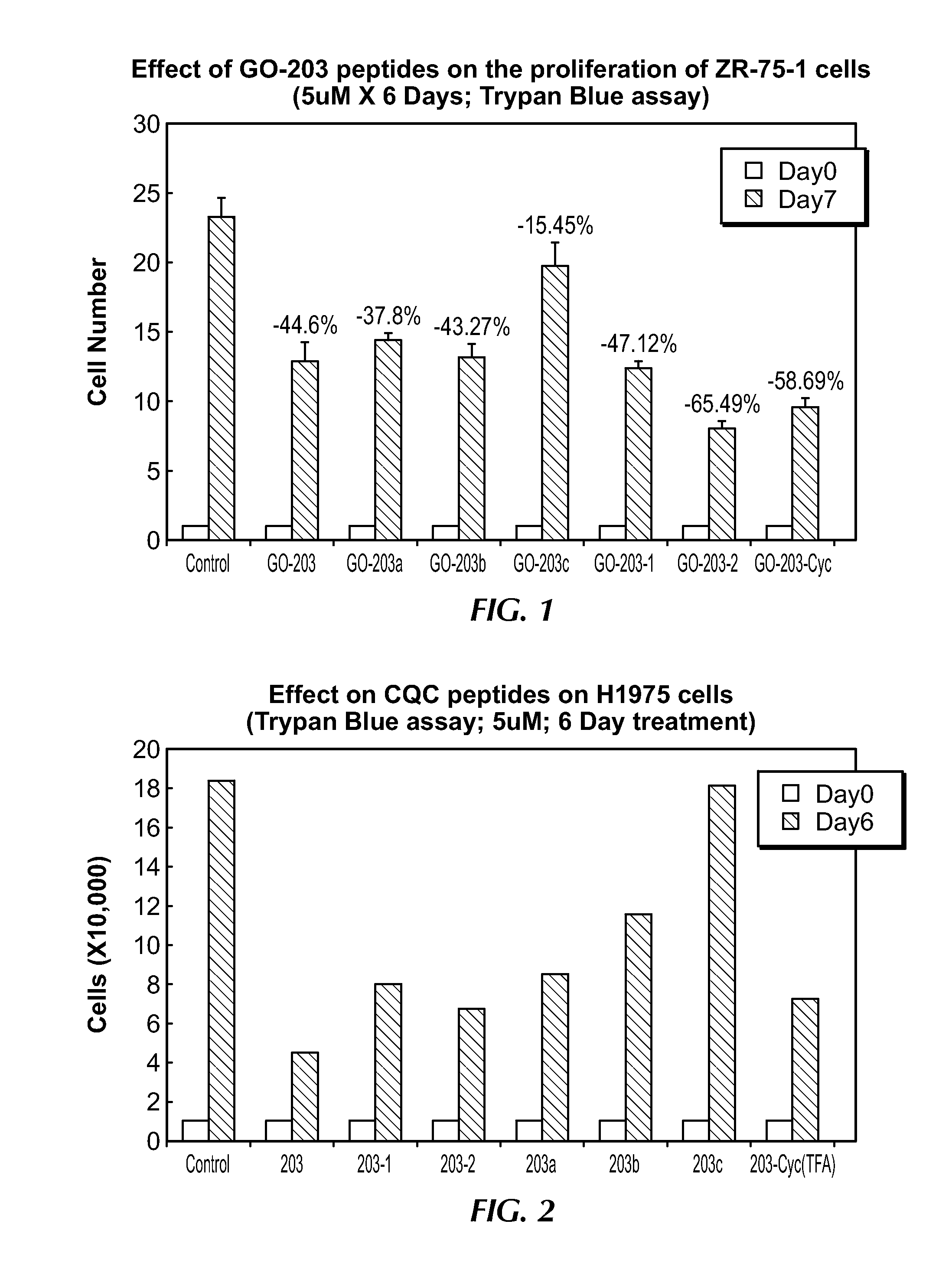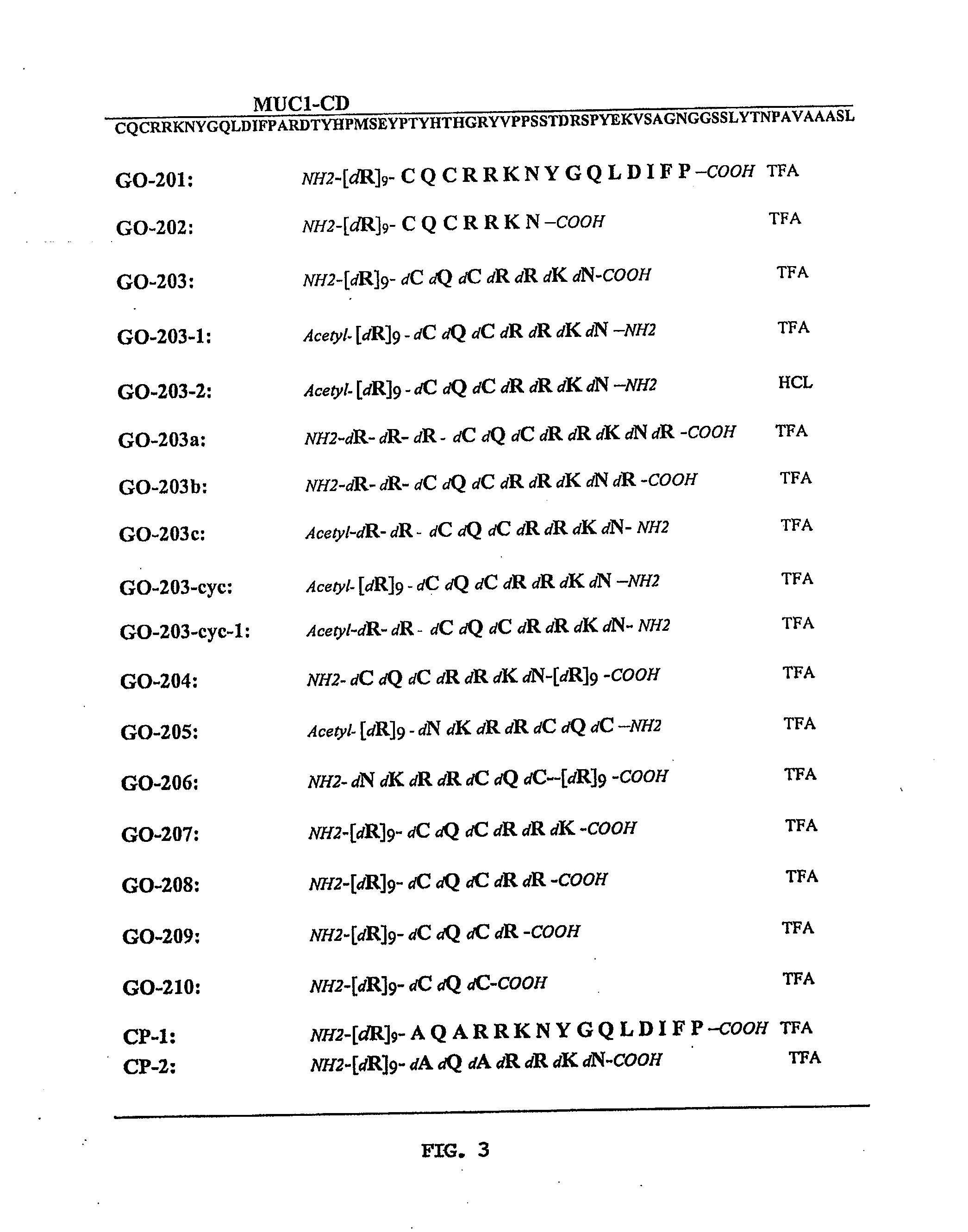Antagonists of muc1
a technology of muc1 and antagonists, which is applied in the direction of peptides/proteins, drug compositions, peptides, etc., can solve the problems of delivering drugs across the skin, preventing muc1 competition, and not having many clinical applications, so as to inhibit the competition of muc1
- Summary
- Abstract
- Description
- Claims
- Application Information
AI Technical Summary
Benefits of technology
Problems solved by technology
Method used
Image
Examples
example 1
Materials and Methods
[0234]Assay for Inhibition of cell Proliferation. Cells (ZR-75-1 breast carcinoma or H-1975 non-small cell lung carcinoma) were plated separately in 24-well plates for 24 hours prior to treatment with different peptides. The cells were then treated with 5 μM (final concentration) of different peptides every day for 4-6 days. On the day of termination, cells were washed two times with PBS and trypsinized with 0.3 ml of Trypsin / EDTA. Cell growth media was used to stop the trypsin reaction. Following washing, the cells were centrifuged and the cell pellets were re-suspended in PBS for counting in hemacytometer.
[0235]The trypan blue dye exclusion method was used to determine the number of viable cells present in a cell suspension. Cell suspension was mixed as 1:1 with the trypan blue dye and then visually examined in a hemacytometer. A viable cell will have a clear cytoplasm whereas a non-viable / dead cell will be stained with trypan blue dye. By doing this trypan bl...
example 2
Results
[0236]The results of experiments following the methods described above a shown below in Table 1 and Table 2, and FIGS. 1 and 2, respectively. As can be seen in FIG. 3, the sequences of GO-203a, -203b and -203c do not have a full nine residue poly-Arg tail, but rather have 4 (3+1), 3 (2+1) and 2 (2+0) Arg residues added.
TABLE 1ZR-75-1 Breast cancer cells 6-day treatment with CQC PeptidesGroup-1*Group-2*Group-3*Avg% inhibitionControl26.622.0421.4523.36—GO-20311.414.9212.4512.9244.0GO-203a15.1714.6213.514.5337.8GO-203b12.9515.1911.6213.2543.27GO-203c17.4324.0217.8119.7515.45GO-203-111.2513.3812.4212.3547.1GO-203-27.149.387.678.0665.49GO-203-2c9.1811.228.559.8358.69*Group 1-3 are individual wells, each having 10,000 cells
TABLE 2H1975 Lung cancer cells cancer cells6-day treatment with CQC PeptidesGroup-1*Group-2*Group-3*Avg% inhibitionControl18.2718.0418.6818.32—GO-2034.425.483.434.4475.76GO-203a8.018.988.588.5253.47GO-203b12.7510.011.811.5137.13GO-203c16.8719.8717.5418.091.24GO-2...
example 3
Cyclized Peptide GO-203-2c
[0237]A series of in vitro and in vivo primary pharmacodynamic studies was conducted to assess efficacy and mechanism of action of GO-203-2c in human tumor cells. GO-203-2c, and the reduced form of the molecule, GO-203-2, inhibited proliferation of a variety of human carcinoma cell lines in vitro, with 50% inhibition (IC50) occurring at concentrations of approximately 2 to 5 μM (5 to 11 μg / ml). In a ZR-75-1 human breast carcinoma xenograft model, intravenous (IV) treatment with GO-203-2c at 4 mg / kg daily for 21 consecutive days resulted in complete regression of established subcutaneous (SC) tumors in nu / nu mice. Treatment with 1 mg / kg GO-203-2c was associated with partial tumor regression in the model. Similarly, in a MiaPaCa human pancreatic carcinoma xenograft model, daily IV treatment with GO-203-2c (10 mg / kg) for 21 consecutive days resulted in significant arrest of tumor growth, with 2 of 8 mice tumor-free at the end of treatment. In both in vitro and...
PUM
| Property | Measurement | Unit |
|---|---|---|
| pH | aaaaa | aaaaa |
| molecular weight | aaaaa | aaaaa |
| diameter | aaaaa | aaaaa |
Abstract
Description
Claims
Application Information
 Login to View More
Login to View More - R&D
- Intellectual Property
- Life Sciences
- Materials
- Tech Scout
- Unparalleled Data Quality
- Higher Quality Content
- 60% Fewer Hallucinations
Browse by: Latest US Patents, China's latest patents, Technical Efficacy Thesaurus, Application Domain, Technology Topic, Popular Technical Reports.
© 2025 PatSnap. All rights reserved.Legal|Privacy policy|Modern Slavery Act Transparency Statement|Sitemap|About US| Contact US: help@patsnap.com



